Ukrainian doctors working in extreme conditions count on US peers' help
Reporter Kristen Jordan Shamus and visual journalist Mandi Wright of the Free Press, part of the USA TODAY Network, visited Poland in May, near the border with Ukraine. They followed a group of U.S. doctors who traveled to Poland to treat Ukrainian children with burns and congenital abnormalities, the first such trip since Russia invaded Ukraine in February 2022. The doctors, from Michigan, Texas, Massachusetts and Missouri, operated on 20 children during their visit. Shamus and Wright had extraordinary access to the doctors and families, and in the hospital. To contribute to Doctors Collaborating to Help Children, go to dctohc.org/donations.
LECZNA, Poland — When the first missiles flew and the air raid sirens wailed at the start of the Russian invasion of Ukraine, Dr. Oleksii Vlasov, chief general of the Regional Medical Center of Family Health in Dnipro, acted quickly.
"We had to move operations underground," he said. For the safety of the patients and the staff, "everything that the team needed all had to go underground: medicine, lights, water filtration, everything."
The hospital was constructed when Ukraine was still a republic in the former Soviet Union, with a massive, bunker-like underground storage area typical of the Cold War era.
That space was transformed in late February 2022 into a working subterranean hospital, Vlasov said. Beds, supplies and equipment were all moved to the basement. Makeshift operating rooms were created, along with a labor and delivery unit and neonatal intensive care unit. Several times, they relied on generator power.
'We try to lead a normal life'
“Before the war, we didn’t understand why all of that was built underground," Vlasov said while in Poland last month working with U.S. doctors on Ukrainian children with severe burns or congenital abnormalities. "We never could have imagined that our children would have to be cured and treated in the underground. It is not such a beautiful place.
“We had a lot to do to make that happen."
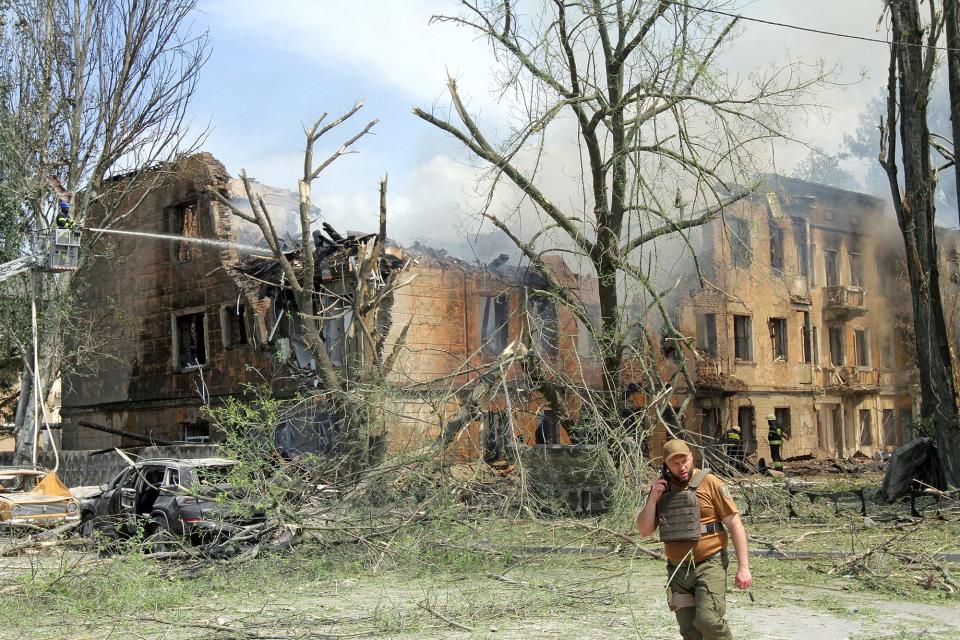
For months, patients were treated in the bunker. By the end of the summer, Vlasov and other hospital leaders made the decision to move operations aboveground again.
Still, they know, danger is never far away. Recently, a Russian missile struck another hospital in Dnipro, killing two and injuring 30.
It wasn't their hospital this time. It wasn't their kids, but the future offers no guarantees.
More: US doctors travel to edge of war zone to care for burned Ukrainian children
More: She was badly burned taking a selfie, then became a war refugee. Now US doctors help her.
"I am aware that if a rocket hits our house, nothing will compensate for the hit and save us — neither taped windows, nor walls, nor basement," said Dr. Artem Posunko, a plastic surgeon at Regional Medical Center. "Hoping for otherwise is pointless.
"Three weeks ago, a rocket fell 1 kilometer from my house. One week ago, a rocket fell close to my parents’ house in Pavlohrad on a fuel warehouse. The blast shattered more than half of the windows in the city. We understand the threat. We feel it, but there is no point in being afraid of the inevitable. We simply avoid excessive, unnecessary risk," he said.
"We try to lead a normal life" — as normal as anything can be in much of Ukraine right now.
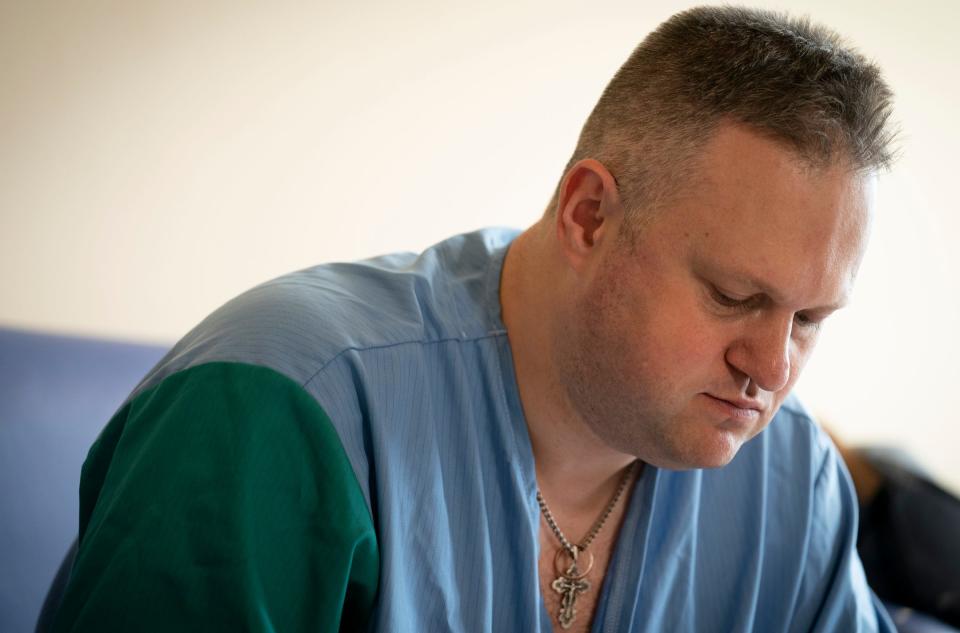
More than 200 children treated for war injuries
"We have learned to work in the reality of war, and recognize which alarms are dangerous, which are not, how and where we should evacuate our patients," Posunko said. "We also see different types of injuries now, the ones that earlier happened very seldom — combat injuries, blast wounds."
The hospital where these doctors work has been designated as a trauma center, where, Posunko said, "we stabilize patients, prepare them for transport and send them farther west if they require longer treatment. All this to ensure we have a required capacity to save lives."
Doctors there have treated more than 200 children who've been injured in the 15-month-long Russian invasion, said Dr. Alex Gladkyy, chief of surgery. That accounts for at least 20% of all the Ukrainian children who've had trauma injuries thus far, he estimated, and it includes 25 kids who arrived at once in April 2022, after a railway station was bombed in Kramatorsk.
"It’s a lot to always have to be ready for something bad at all times," Gladkyy said. "I try to listen and read all the news so I can know how much time I have to be ready for patients. ... It is very hard for morale."
More: Ukrainian boy 'was dying on the operating table, and they saved him'
More: She watched a Russian bomb land near her son — and change their lives
And for the Ukrainian doctors, who face the horrors of war on the job daily, there's no escape at home.
Gladkyy held up his cellphone, showing pictures he took of the nine-story apartment building in ruins across the street from where he lives with his wife and young daughter.
'We couldn’t imagine a second year of the war'
“This is the view from the window of my house,” he said. The building was struck by a Russian missile on Jan. 14, Orthodox New Year. The explosion toppled his Christmas tree, knocked things off shelves and shattered all of his windows.
“It was a holiday, a Saturday,” he said. “My daughter is 3, and she was very afraid. For two weeks, we couldn’t live in our house because we had no gas, no electricity, no water.”
His family wasn't hurt, but more than 40 of his neighbors were killed. Among them was a 16-year-old girl. Her leg, buttock and side were torn open in the blast. He said doctors at his hospital worked to stabilize her wounds, and she was transferred to Lviv for ongoing treatment, where she ultimately died.
“It was very hard. ... This is what is happening,” he said. “Nobody was ready for this. We couldn’t imagine a second year of the war. In general, the doctors and nurses at the hospital work with extreme tension."
US doctors have helped all along
What has helped, Vlasov said, is having the support of some of America's leading physicians, who have offered virtual consultations, shipments of supplies and even a mission trip in mid-May, when 17 Ukrainian children were evacuated from the war-torn country to eastern Poland for complex plastic and reconstructive surgery. Three other kids living as refugees in Poland and the Netherlands also were brought to the Independent Public Health Care Facility in Leczna for treatment.
It was the first time since the war began that U.S. doctors treated Ukrainian children in Poland.
"These operations are not always possible in Ukraine for various reasons," Posunko said. The procedures are costly, he said, and at a time of war, surgeries that save lives — not just improve the quality of their lives — are prioritized. "We would like to perform these operations in Ukraine, too. We strive to do that one day."
More: A burned little girl and her great-grandmother: 'We will handle this'
Most of the children were scalded by hot water, severely burned in fires, suffered electrical injuries or had congenital abnormalities. One boy, Artem Sokolov, 11, of Kharkiv, suffered injuries to his left arm and hand in a cluster bomb attack. Many of the kids will need repeated surgeries to maintain mobility and avoid crippling deformities caused by thick, inflexible burn scars that don't stretch as they grow.
The convergence in Poland was the latest in more than a decade of mission trips organized by Dr. Gennadiy Fuzaylov, a Boston-based physician and philanthropist who founded the nonprofit Doctors Collaborating to Help Children.
Michigan doc helps Ukrainian peers with pioneering treatment
Dr. Jeremi Mountjoy, an anesthesiologist from Massachusetts General Hospital who traveled with the team on the mission trip to Poland, said education might be the most important element of the collaboration.
"If you just come in and help a few people and then leave, your impact is far smaller than if you could ... bring up the level of care the Ukrainian doctors are able to provide," he said, noting that it was the U.S. team that first introduced the use of laser treatments for burned patients to the country.
"Gennadiy worked with the Ministry of Health to get permission to bring the first-ever burn laser to Ukraine," Mountjoy said. "And they use that quite a bit now as an adjunct to the larger surgeries we're doing. We did a lot of training with the local surgeons in Lviv and left the laser there for them."
When used to treat burn scars, lasers create microinjuries on the skin. They gradually burn away the old, thicker scars, he explained. When steroid ointments are added to slow and control the healing process, it often leaves patients with softer, more flexible skin.
That's not all.
When the war began, Fuzaylov and Dr. David Brown, a plastic surgeon from the University of Michigan, introduced a new treatment to help ease the phantom pain or nerve pain people often feel after an amputation.
"Whenever there's a war, there are far more amputations and war-related injuries that result in someone, a soldier, losing an arm or leg," Brown said. "At the University of Michigan, we've done pioneering work in helping amputation patients ... either prevent or treat amputation nerve pain or phantom pain.
"We've invented techniques to help treat those nerves surgically."
Dr. Brian Kelley, who trained in plastic surgery at U-M with Brown and Dr. Paul Cederna, said he was part of the Ann Arbor-based team that performed the first such phantom pain procedure on a human anywhere in the world.
"And now, I teach it in Texas," said Kelley, who works as a plastic surgeon at the University of Texas at Austin Dell Medical School. "And Dr. Brown and I were doing sessions with Ukrainian neurosurgeons. ... We're teaching them to do it."
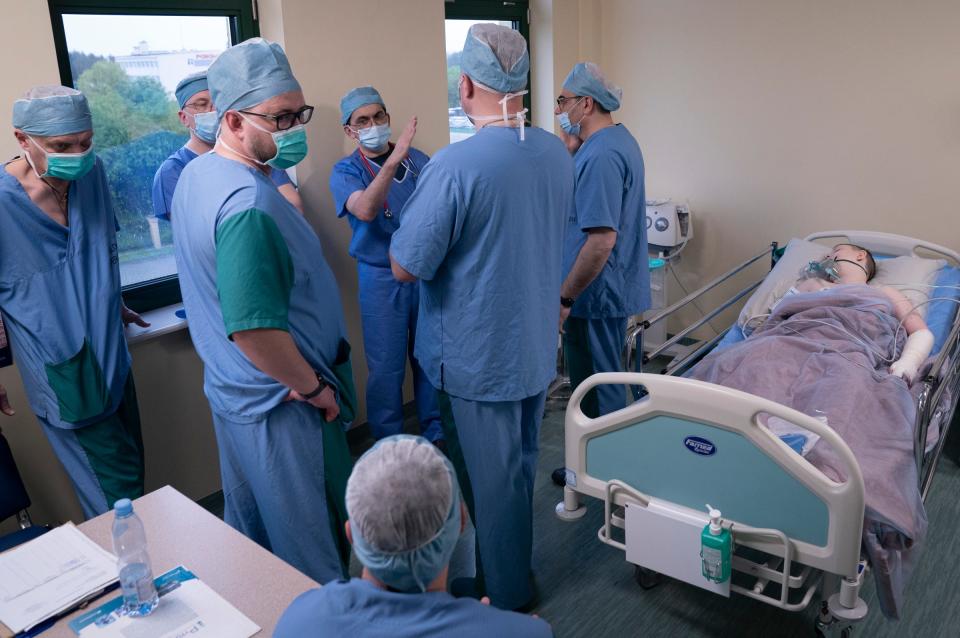
What's happening in the war in Ukraine, he said, is similar to what happened in Afghanistan, when scores of soldiers lost limbs in bomb blasts.
"Everyone is coming back with legs missing and phantom pain," Kelley said. "So we were discussing cases with the Ukrainian doctors while we're in Poland so they can go back and do the surgeries at home."
Vlasov said his hospital was the first in Ukraine to treat phantom pain using this procedure, and it was done entirely virtually.
"We were in an operating room doing the operation through a screen," he said. "They saw and controlled our movements, and we asked for suggestions about what to do. It was like a virtual surgery."
By mid-May, Brown estimated, at least 20 phantom pain and chronic nerve pain prevention procedures had been performed on amputees in Ukraine.
"That's really super exciting," Brown said.
More learning and new devices for European doctors
That's what impactful global health outreach looks like, said Dr. Justin Knittel, an anesthesiologist at Washington University School of Medicine in St. Louis.
“What people don't realize is that building the relationships is what we're here for," he said. "We're not here just to do the operations. We are bringing them our minds and our collaboration."
Knittel also brought a new device with him to Poland to give to both the Ukrainian and Polish physicians.
Called Through the Cords, it's a flexible plastic guide that anesthesiologists can use when inserting a breathing tube in patients with difficult airways.
"We have to create a direct line from our eyes to the vocal cords, which requires moving tissue out of the way," Knittel said. "It's the most dangerous thing we do because you’ve got to breathe to survive. In anesthesia, we can kill someone faster than anyone else in medicine.
"One of the principles we have in global health, especially doing procedures in global environments, is to have zero complications. And so, when we take on tasks that involve the airway, we have to be not just confident, but 100% confident that we can handle it.
"Normally, you can never guarantee that. So any tools that could help us get out of trouble, especially tools that don't take electricity, a lot of space, high levels of technology — anything that’s simple — is a benefit. And this is a very simple tool."
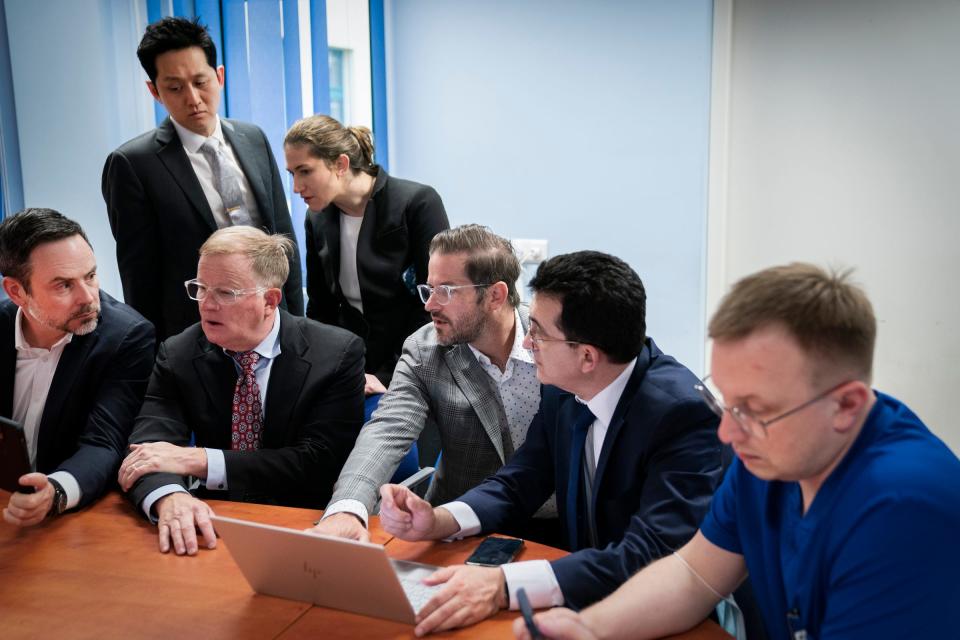
'A lot of what we do is an art'
The education, Knittel said, goes both ways on these mission trips. American doctors have plenty to learn, too.
"You really learn about the depth of your skills when you go somewhere else and have to put it all to use," he said. "And so we've learned to be comfortable in a lot of situations where we may not normally be very comfortable.
"We learned to trust ourselves. We learned that a lot of what we do is an art and not necessarily based on evidence. There's a lot of cultural things we do. And so by seeing how other people do it in a different situation, we can learn about our own practice, and evaluate what actually works, what doesn't and consider other ways of doing things."
Fuzaylov is learning, too.
One afternoon, as Fuzaylov and his team of doctors checked on the children who'd had surgery earlier that day, he saw a little girl crying on the hospital floor.
"I asked her, 'What's wrong, sweetheart?' And she told me, 'You didn't give me a hug today,'" Fuzaylov said. He hadn't stopped to see her that afternoon because she hadn't yet had surgery. But it was clear, he said, that her feelings were hurt.
"About 40% of the patients who came here to Poland have been with us on missions before. They are attached to us ... and if they don't give me a hug, they get upset."
From that moment on, he told the medical team that every child was to get a daily visit and a hug if they wanted one. Every child would see the doctors dressed professionally to greet them, too.
"Putting on the professional clothes shows respect for the patients," he said.
It's acts of kindness like these — not just from the American physicians, but from others around the world — that humble the Ukrainian doctors.
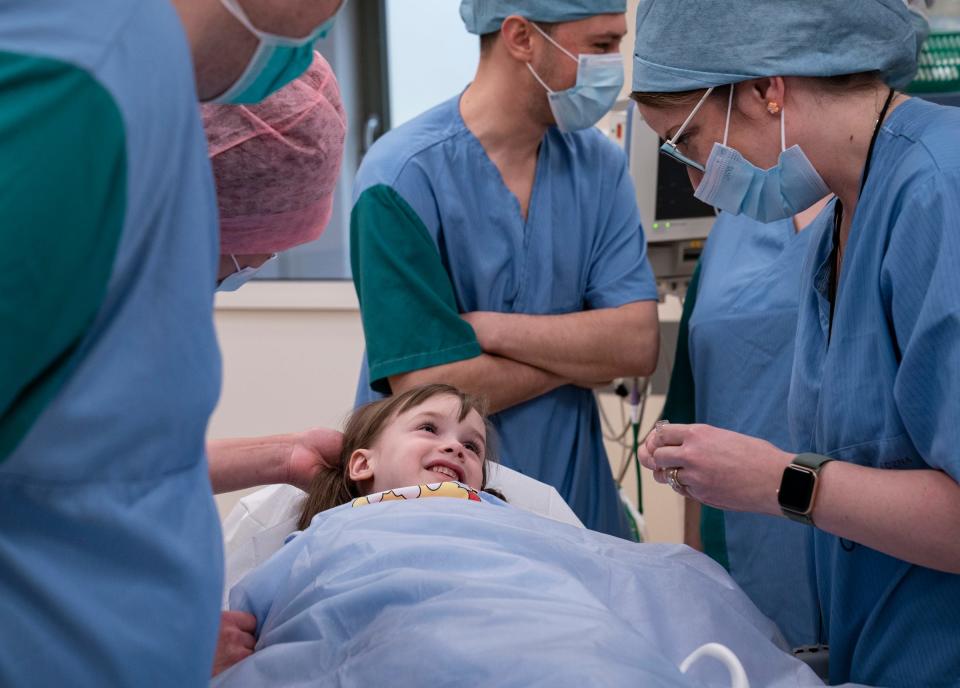
Dr. Maxim Savenko recalls what happened when his wife, daughter and son fled to the Netherlands at the start of the war.
“When my family crossed the border into Poland, and they needed huge help from the volunteers from Poland," said Savenko, a plastic surgeon from Dnipro State Medical University. "And when I talked to my daughter, and she cried, and she told me: ‘Papa, I couldn’t imagine that people could be so kind.’”
They gave her blankets and hot tea.
“She couldn’t imagine such warmth, such goodness, such kindness."
Vlasov said ongoing international generosity of all kinds is still needed to get the Ukrainian people through this crisis.
"All aid is very important," he said. "Everybody in the world needs to know about it. If other people don’t know about it, there’s no potential for them to do something to help.”
Zuza Nikitorowicz translated interviews for this article.
To contribute to Doctors Collaborating to Help Children, go to dctohc.org/donations.
This article originally appeared on Detroit Free Press: Ukrainian doctors working in extreme conditions rely on US peers' help

